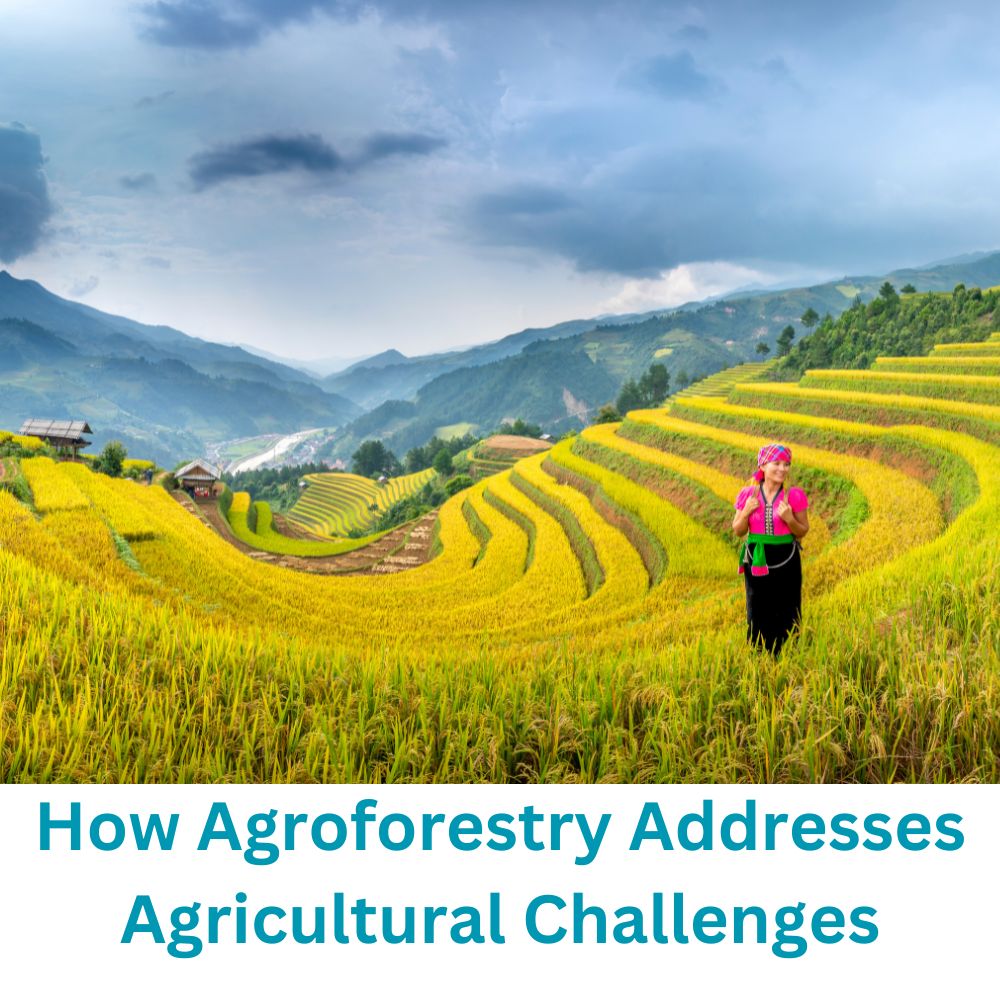Introduction
In the face of increasing agricultural challenges such as land degradation, climate change, and biodiversity loss, agroforestry emerges as a symbiotic solution, offering a harmonious blend of agriculture and forestry. This 1500-word article delves into how agroforestry addresses these pressing issues, providing sustainable and resilient agricultural practices.
Understanding Agroforestry
At its core, agroforestry involves integrating trees and shrubs into crop and livestock farming systems. It creates a dynamic, symbiotic relationship between different components of agriculture and forestry, leading to enhanced productivity, biodiversity, and ecological balance. The diversity of agroforestry systems – from silvopastoral systems combining trees with pasture to agrosilvicultural systems integrating crops and trees – offers versatile solutions to various agricultural landscapes.
Addressing Land Degradation
One of the foremost challenges in agriculture is land degradation, which threatens food security and livelihoods. Agroforestry systems combat soil erosion, improve soil fertility, and enhance land resilience. The deep rooting systems of trees and shrubs prevent soil erosion, while leaf litter and organic matter from trees enrich the soil, improving its structure and nutrient content.
Combating Climate Change
Agroforestry is a potent tool in the fight against climate change. Trees in agroforestry systems act as carbon sinks, absorbing CO2 from the atmosphere. This carbon sequestration is crucial in mitigating the effects of climate change. Additionally, agroforestry practices contribute to climate change adaptation by diversifying farm production and reducing vulnerability to climate extremes such as droughts and floods.
Promoting Biodiversity
Agroforestry systems are hotspots of biodiversity. By combining different plant species with varied habitats, these systems support a wide range of wildlife. This biodiversity not only enhances the resilience of the ecosystem but also provides ecological services such as pollination, pest control, and disease regulation, which are crucial for sustainable agriculture.
Enhancing Water Management
Effective water management is vital for agriculture. Agroforestry helps conserve water through improved soil structure, which enhances water infiltration and reduces runoff. The shade provided by trees also reduces water evaporation from the soil, saving moisture. Furthermore, agroforestry systems can play a role in watershed management, improving water quality and availability.
Boosting Farm Productivity and Diversification
Agroforestry contributes to increased farm productivity by providing multiple outputs. Trees can provide fruits, nuts, timber, and fodder alongside traditional crop or livestock products, thus diversifying farmer income sources. This diversification also reduces the risk associated with crop failures and market fluctuations, enhancing the economic resilience of farming communities.
Improving Livelihoods and Economic Benefits
Agroforestry offers significant economic benefits. Selling timber, non-timber forest products, and diversified crops can provide substantial income for farmers. Additionally, by enhancing the productivity and sustainability of land, agroforestry ensures long-term economic benefits and food security for future generations.
Socio-Cultural Aspects
Agroforestry also plays a role in preserving socio-cultural values. Many agroforestry practices are based on traditional knowledge, contributing to conserving indigenous farming practices and local biodiversity. Furthermore, agroforestry can strengthen community bonds, as it often involves collective management and sharing of resources.
Policy and Institutional Support
Policy and institutional support are essential for agroforestry to effectively address agricultural challenges. Governments and international bodies can significantly promote agroforestry through supportive policies, research and development, and incentives for farmers. Integration of agroforestry into national agricultural policies can accelerate its adoption and impact.
Challenges and Limitations
Despite its benefits, agroforestry faces challenges in implementation. These include land tenure issues, the need for more awareness, and initial investment costs. Additionally, the slow growth of trees can delay the realization of benefits, which might discourage farmers. Addressing these challenges requires targeted policies, education, and financial support.
Case Studies and Success Stories
The article can include case studies from various parts of the world where agroforestry has successfully addressed agricultural challenges. For instance, the regeneration of degraded lands in Niger through farmer-managed natural regeneration or the success of coffee and cocoa agroforestry systems in Central America, which have improved biodiversity and farmers’ income.
Future Directions and Research Needs
Looking ahead, research and innovation in agroforestry are crucial. Future research needs to focus on optimizing agroforestry designs for different ecological zones, developing climate-resilient species, and understanding the socio-economic impacts of agroforestry practices. There is also a need for greater collaboration between researchers, policymakers, and farmers to scale up successful models.
Education and Capacity Building
Investing in education and capacity building is essential to maximize the benefits of agroforestry. Training programs for farmers, extension services, and educational campaigns can raise awareness about the benefits of agroforestry and provide the necessary skills for its implementation.
Conclusion
Agroforestry stands as a beacon of hope in addressing contemporary agricultural challenges. By fostering ecological balance, enhancing productivity, and supporting sustainable livelihoods, agroforestry presents a path towards a more resilient and sustainable farming future. Its success, however, hinges on collective efforts – integrating science, policy, and community engagement to unlock its full potential.
This comprehensive article explores how agroforestry addresses various agricultural challenges, offering sustainable solutions through ecological and economic lenses. It highlights the importance of policy support, community involvement, and ongoing research and education in realizing the full potential of agroforestry practices.
